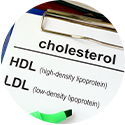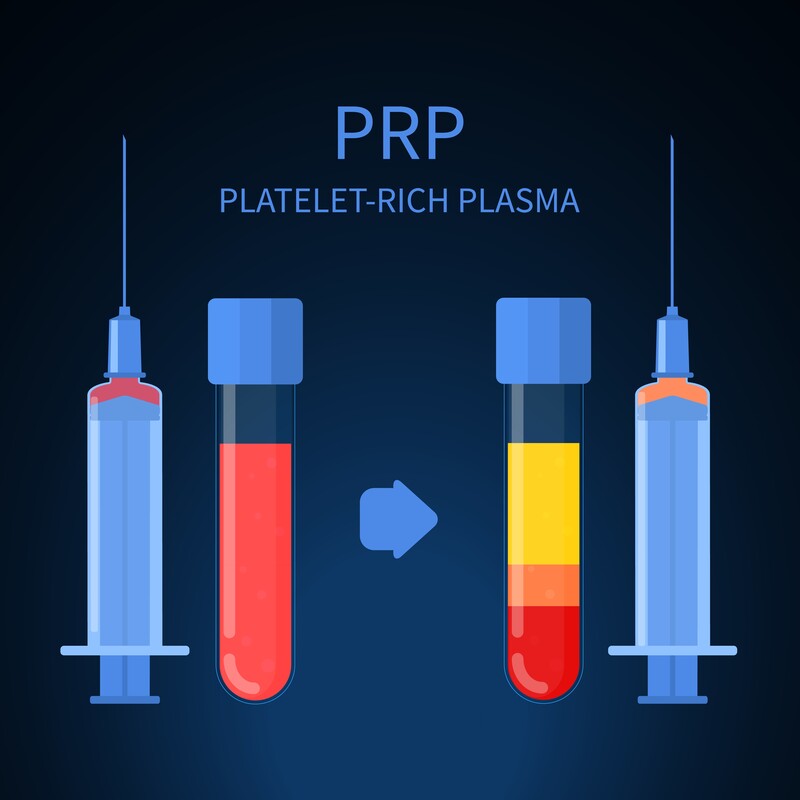We will often see a new patient who has tried numerous types of treatments for their knee pain. They will tell us about “gel shots,” and they will tell us about their successes or lack of success with cortisone. Because these injections did not provide the level of pain relief and restoration of movement that they were hoping for, many will find themselves in our office looking at options.
One option is Platelet Rich Plasma injections
In nature, the body’s response to soft tissue injury is to deliver platelets to the site of the injury, or in this case, to the site of knee degeneration. Platelets carry cells, proteins, and other growth and healing factors that initiate repair and attract the critical assistance of stem cells (the kingpins of regenerative medicine) to the site where the platelets have initialed repair. PRP‘s, (Platelet Rich Plasma injections) natural healing process intensifies the body’s efforts by delivering a higher concentration of platelets to revive a “failed healing.”
To create PRP therapy, a small sample of your blood is drawn (similar to a lab test sample) and placed in a centrifuge that spins the blood at high speeds, separating the platelets from the other components. The concentrated platelet rich plasma (PRP) is then injected into and around the point of injury, jump-starting and significantly strengthening the body’s natural healing signal. Because your own blood is used, there is no risk of a transmissible infection and a very low risk of allergic reaction.
Because the goal of PRP therapy is to resolve pain through healing, it could prove to have lasting results. Initial improvement may be seen within a few weeks, gradually increasing as the healing progresses.
Research studies and clinical practice have shown PRP therapy to be very effective at relieving pain and returning patients to their normal lives. Both ultrasound and MRI images have shown definitive tissue repair after PRP therapy, confirming the healing process. The need for surgery can also be greatly reduced by treating injured tissues before the damage progresses and the condition is irreversible.
Recent research, Recent comparisons
Hyaluronic acid injections are marketed under the trade names: Euflexxa, Hyalgan, Orthovisc, Supartz, among others. Synvisc is a chemically modified form of Hyaluronic acid. These treatments can also be referred to as viscosupplementation.
A January 2019 study (1) suggests that while PRP injections, cortisone injections, and hyaluronic acid injections are equally effective at relieving patient symptoms at three months. The difference in the treatment is the long-term effectiveness.
At 6, 9, and 12 months the PRP injections delivered significantly better results.
A July 2020 study (2) offered little doubt that PRP injections provided better results for patients. The study’s conclusions were: Besides significantly higher satisfaction belonging to the (PRP) group, there was a statistically significant improvement in VAS (visual pain score) and Lequesne score (Pain and function improvement) by passing 12 months from injection in PRP compared to hyaluronic acid injections
PRP works best long-term when offered by experienced physicians
Another January 2019 study (3) suggests that while Platelet-rich plasma (PRP) is being increasingly accepted as one of the most effective approaches for the symptomatic treatment of mild to moderate osteoarthritis, the researchers warn that several confounding factors can affect the outcome of PRP such as age, grade of osteoarthritis, PRP processing technique, and number and timing of these injections. (The doctor’s experience in using PRP and how that doctor offers the treatment can make or break the treatments’ success).
Regardless, the study’s researchers report on PRP randomized clinical trials (compared with saline, hyaluronic acid, and other nonsurgical methods) suggest that successful outcomes can be achieved at 1-year post-injection with minimal complications.
Supportive research
PRP has shown itself to be a very effective treatment in clinical studies
A study in the International journal of clinical and experimental medicine (4) said: “In this study (of 118 patients), the intra-articular PRP administration was more efficient than the hyaluronic acid administration in early knee osteoarthritis.”
In another recently released report published in Clinical medicine insights. Arthritis and musculoskeletal disorders, (5) doctors confirmed their findings suggesting Platelet Rich Plasma injections worked better than hyaluronic acid injections in reducing symptoms and improving quality of life in patients with knee osteoarthritis.
One study not only compared hyaluronic acid and PRP injections, but multi-injections of PRP against single dose PRP. These results were published in Clinical neurology and neurosurgery. (6)
Patients treated with 3 PRP injections did significantly better.
Heavier or obese patients did better with PRP
A March 2020 study (7) compared platelet-rich plasma was better than hyaluronic acid for the treatment of knee osteoarthritis in overweight or obese patients. They examined ten randomized controlled trials with 1096 patients included. During the first two months of follow-up, there was no significant difference between the two groups. At the 3rd, 6th, and 12th months of follow-up, the pooled analysis showed that platelet-rich plasma was better than hyaluronic acid for the treatment of knee osteoarthritis in overweight or obese patients. There were significant differences between the two groups. For overweight or obese patients with knee osteoarthritis, intra-articular injection of PRP in a short time was not necessarily superior to hyaluronic acid, but long-term use was better than hyaluronic acid in pain and functional relief.
Hyaluronic acid injections: More harm than good?
Recently investigators looking at the long term benefit of Hyaluronic acid injections found that while they can provide significant pain relief and improvement in activity of daily living function for patients with knee osteoarthritis, the reduction in pain and the increase in knee adduction movement may cause excessive loading on the knee joints, which may further accelerate the rate of knee degeneration. That was published in Clinical neurology and neurosurgery.(8)
Recently doctors published research in the Annals of internal medicine (9) that in patients with knee osteoarthritis, viscosupplementation offered a small and clinically irrelevant benefit and an increased risk for serious adverse events.
In another larger study, researchers found that hyaluronic acid injections only provided a small relief to patients with osteoarthritis of the knee, but agreed that they could provoke both local reactions and serious adverse effects.(10)
How many treatments?
Above we offered some research suggesting multiple treatments. In a May 2021 study (11) doctors evaluated 260 knees in various stages of osteoarthritis (from grades 2 to 4) that were treated with PRP injections. The average age of participants in this study was 61 and 76.9% were women. About one in three of the patients were overweight.
In this study the researchers “demonstrated that intra-articular injection of PRP in osteoarthritis knees in grades II, III and IV are valuable, efficient and cost-effective. Patients observed a decrease in pain and an increase in degree of flexion. The changes were noticeable short term after three, six and nine months of follow-ups. Grade IV gave a good response to injection with improvement in pain and range of flexion, which as a result decreased the possibility of needing knee replacement or delayed it. Multiple injections gave better results than single injection in all grades regardless of their weight.”
Knee pain injections choices – What can I expect during my first visit to the Magaziner Center for Wellness?
The PRP procedure takes approximately one hour, including preparation and recovery time. Performed safely in a medical office, PRP therapy relieves pain without the risks of surgery, general anesthesia, or hospital stays and without a prolonged recovery. In fact, most people return to their jobs or usual activities right after the procedure.
If you would like to explore more information, please contact our office so we can start a conversation with you.
Related articles:
https://drmagaziner.com/knee-pain/stem-cell-treatments-for-bone-on-bone-knees/
Researchers Say Knee Osteoarthritis Patients Need Vitamin D
Researchers Say Knee Osteoarthritis Patients Need Vitamin D
References:
These publications were cited in this article:
1 Huang Y, Liu X, Xu X, Liu J. Intra-articular injections of platelet-rich plasma, hyaluronic acid or corticosteroids for knee osteoarthritis. Der Orthopäde. 2019 Jan 8:1-8.
2 Raeissadat SA, Gharooee Ahangar A, Rayegani SM, Minator Sajjadi M, Ebrahimpour A, Yavari P. Platelet-Rich Plasma-Derived Growth Factor vs Hyaluronic Acid Injection in the Individuals with Knee Osteoarthritis: A One Year Randomized Clinical Trial. J Pain Res. 2020;13:1699-1711. Published 2020 Jul 8. doi:10.2147/JPR.S210715
3 Chahla J, Cole BJ. Editorial Commentary: Platelet-Rich Plasma for Knee Osteoarthritis: A “Novel” and Effective Symptomatic Approach.
4 Kilincoglu V, Yeter A, Servet E, Kangal M, Yildirim M. Short term results comparison of intraarticular platelet-rich plasma (prp) and hyaluronic acid (ha) applications in early stage of knee osteoarthritis. Int J Clin Exp Med. 2015 Oct 15;8(10):18807-12. eCollection 2015.
5 Raeissadat SA, Rayegani SM, Hassanabadi H, Fathi M, Ghorbani E, Babaee M, Azma K. Knee Osteoarthritis Injection Choices: Platelet- Rich Plasma (PRP) Versus Hyaluronic Acid (A one-year randomized clinical trial). Clin Med Insights Arthritis Musculoskelet Disord. 2015 Jan 7;8:1-8. doi: 10.4137/CMAMD.S17894. eCollection 2015.
6 Görmeli G, Görmeli CA, Ataoglu B, Çolak C, Aslantürk O, Ertem K. Multiple PRP injections are more effective than single injections and hyaluronic acid in knees with early osteoarthritis: a randomized, double-blind, placebo-controlled trial. Knee Surg Sports Traumatol Arthrosc. 2015 Aug 2.
7 Luo P, Xiong Z, Sun W, Shi L, Gao F, Li Z. How to Choose Platelet-Rich Plasma or Hyaluronic Acid for the Treatment of Knee Osteoarthritis in Overweight or Obese Patients: A Meta-Analysis. Pain Res Manag. 2020 Mar 10;2020:7587936. doi: 10.1155/2020/7587936. PMID: 32322326; PMCID: PMC7085849.
8 Tang AC, Tang SF, Hong WH, Chen HC. Kinetics features changes before and after intra-articular hyaluronic acid injections in patients with knee osteoarthritis. Clin Neurol Neurosurg. 2015 Feb;129 Suppl 1:S21-6. doi: 10.1016/S0303-8467(15)30007-X.
9 Rutjes AWS, Jüni P, MD; da Costa BR, et al. Viscosupplementation for Osteoarthritis of the Knee: A Systematic Review and Meta-analysis. Ann Intern Med. 2012 Jun 11.
10 Intra-articular hyaluronic acid injection: not for gonarthrosis. Prescrire Int. 2013 Oct;22(142):248-9.
11 Hegaze AH, Hamdi AS, Alqrache A, Hegazy M. Efficacy of Platelet-Rich Plasma on Pain and Function in the Treatment of Knee Osteoarthritis: A Prospective Cohort Study. Cureus. 2021 Mar;13(3).





































Recent Comments